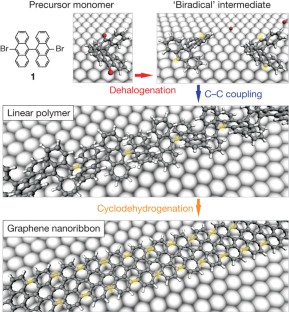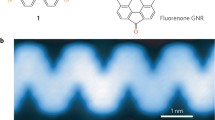Abstract
Graphene nanoribbons—narrow and straight-edged stripes of graphene, or single-layer graphite—are predicted to exhibit electronic properties that make them attractive for the fabrication of nanoscale electronic devices1,2,3. In particular, although the two-dimensional parent material graphene4,5 exhibits semimetallic behaviour, quantum confinement and edge effects2,6 should render all graphene nanoribbons with widths smaller than 10 nm semiconducting. But exploring the potential of graphene nanoribbons is hampered by their limited availability: although they have been made using chemical7,8,9, sonochemical10 and lithographic11,12 methods as well as through the unzipping of carbon nanotubes13,14,15,16, the reliable production of graphene nanoribbons smaller than 10 nm with chemical precision remains a significant challenge. Here we report a simple method for the production of atomically precise graphene nanoribbons of different topologies and widths, which uses surface-assisted coupling17,18 of molecular precursors into linear polyphenylenes and their subsequent cyclodehydrogenation19,20. The topology, width and edge periphery of the graphene nanoribbon products are defined by the structure of the precursor monomers, which can be designed to give access to a wide range of different graphene nanoribbons. We expect that our bottom-up approach to the atomically precise fabrication of graphene nanoribbons will finally enable detailed experimental investigations of the properties of this exciting class of materials. It should even provide a route to graphene nanoribbon structures with engineered chemical and electronic properties, including the theoretically predicted intraribbon quantum dots21, superlattice structures22 and magnetic devices based on specific graphene nanoribbon edge states3.




Similar content being viewed by others
References
Wakabayashi, K. Electronic transport properties of nanographite ribbon junctions. Phys. Rev. B 64, 125428 (2001)
Barone, V., Hod, O. & Scuseria, G. E. Electronic structure and stability of semiconducting graphene nanoribbons. Nano Lett. 6, 2748–2754 (2006)
Son, Y. W., Cohen, M. L. & Louie, S. G. Half-metallic graphene nanoribbons. Nature 444, 347–349 (2006)
Novoselov, K. S. et al. Electric field effect in atomically thin carbon films. Science 306, 666–669 (2004)
Geim, A. K. Graphene: status and prospects. Science 324, 1530–1534 (2009)
Yang, L., Park, C. H., Son, Y. W., Cohen, M. L. & Louie, S. G. Quasiparticle energies and band gaps in graphene nanoribbons. Phys. Rev. Lett. 99, 186801 (2007)
Datta, S. S., Strachan, D. R., Khamis, S. M. & Johnson, A. T. C. Crystallographic etching of few-layer graphene. Nano Lett. 8, 1912–1915 (2008)
Campos-Delgado, J. et al. Bulk production of a new form of sp(2) carbon: crystalline graphene nanoribbons. Nano Lett. 8, 2773–2778 (2008)
Yang, X. Y. et al. Two-dimensional graphene nanoribbons. J. Am. Chem. Soc. 130, 4216–4217 (2008)
Li, X. L., Wang, X. R., Zhang, L., Lee, S. W. & Dai, H. J. Chemically derived, ultrasmooth graphene nanoribbon semiconductors. Science 319, 1229–1232 (2008)
Chen, Z. H., Lin, Y. M., Rooks, M. J. & Avouris, P. Graphene nano-ribbon electronics. Physica E 40, 228–232 (2007)
Han, M. Y., Ozyilmaz, B., Zhang, Y. B. & Kim, P. Energy band-gap engineering of graphene nanoribbons. Phys. Rev. Lett. 98, 206805 (2007)
Jiao, L. Y., Zhang, L., Wang, X. R., Diankov, G. & Dai, H. J. Narrow graphene nanoribbons from carbon nanotubes. Nature 458, 877–880 (2009)
Kosynkin, D. V. et al. Longitudinal unzipping of carbon nanotubes to form graphene nanoribbons. Nature 458, 872–875 (2009)
Elías, A. L. et al. Longitudinal cutting of pure and doped carbon nanotubes to form graphitic nanoribbons using metal clusters as nanoscalpels. Nano Lett. 10, 366–372 (2009)
Jiao, L., Wang, X., Diankov, G., Wang, H. & Dai, H. Facile synthesis of high-quality graphene nanoribbons. Nature Nanotechnol. 5, 321–325 (2010)
Grill, L. et al. Nano-architectures by covalent assembly of molecular building blocks. Nature Nanotechnol. 2, 687–691 (2007)
Gourdon, A. On-surface covalent coupling in ultrahigh vacuum. Angew. Chem. Int. Edn Engl. 47, 6950–6953 (2008)
Otero, G. et al. Fullerenes from aromatic precursors by surface-catalysed cyclodehydrogenation. Nature 454, 865–868 (2008)
Rim, K. T. et al. Forming aromatic hemispheres on transition-metal surfaces. Angew. Chem. Int. Edn Engl. 46, 7891–7895 (2007)
Huang, L., Lai, Y. C., Ferry, D. K., Akis, R. & Goodnick, S. M. Transmission and scarring in graphene quantum dots. J. Phys. Condens. Matter 21, 344203 (2009)
Sevincli, H., Topsakal, M. & Ciraci, S. Superlattice structures of graphene-based armchair nanoribbons. Phys. Rev. B 78, 245402 (2008)
Malard, L. M., Pimenta, M. A., Dresselhaus, G. & Dresselhaus, M. S. Raman spectroscopy in graphene. Phys. Rep. 473, 51–87 (2009)
Vandescuren, M., Hermet, P., Meunier, V., Henrard, L. & Lambin, P. Theoretical study of the vibrational edge modes in graphene nanoribbons. Phys. Rev. B 78, 195401 (2008)
Classen, T. et al. Templated growth of metal-organic coordination chains at surfaces. Angew. Chem. Int. Edn Engl. 44, 6142–6145 (2005)
Canas-Ventura, M. E. et al. Self-assembly of periodic bicomponent wires and ribbons. Angew. Chem. Int. Edn Engl. 46, 1814–1818 (2007)
Briggs, D. & Beamson, G. High Resolution XPS of Organic Polymers: The Scienta ESCA300 Database Appendix I (John Wiley & Sons, 1992)
Son, Y. W., Cohen, M. L. & Louie, S. G. Energy gaps in graphene nanoribbons. Phys. Rev. Lett. 97, 216803 (2006)
Lee, Y. et al. Wafer-scale synthesis and transfer of graphene films. Nano Lett. 10, 490–493 (2010)
Caldwell, J. D. et al. Technique for the dry transfer of epitaxial graphene onto arbitrary substrates. ACS Nano 4, 1108–1114 (2010)
Acknowledgements
This work was supported by the Swiss National Science Foundation and the NCCR Nanoscale Science. R.F. and P.R. thank O. Gröning and P. Gröning for stimulating discussions and continued support. A.P.S. acknowledges discussions with F. Mauri and M. Lazzeri. The Mainz group acknowledges financial support from the Max Planck Society through the program ENERCHEM, the German Science Foundation (Korean-German IRTG), the DFG Priority Program SPP 1355 and DFG MU 334/32-1.
Author information
Authors and Affiliations
Contributions
P.R, R.F., X.F. and K.M. conceived the experiments. M.S. synthesized the molecular precursors. J.C., R.J., M.B. and P.R. performed the growth and scanning probe experiments. T.B. and M.M. did the spectroscopic analysis. S.B. and A.P.S. performed the simulations. J.C., P.R. and R.F. prepared the figures. P.R., J.C. and R.F. wrote the paper. All authors discussed the results and implications and commented on the manuscript at all stages.
Corresponding authors
Ethics declarations
Competing interests
The authors declare no competing financial interests.
Supplementary information
Supplementary information
This file contains Supplementary Information including Supplementary Methods, Supplementary Data, Supplementary Figures 1-7 with legends and References. (PDF 2452 kb)
Rights and permissions
About this article
Cite this article
Cai, J., Ruffieux, P., Jaafar, R. et al. Atomically precise bottom-up fabrication of graphene nanoribbons. Nature 466, 470–473 (2010). https://doi.org/10.1038/nature09211
Received:
Accepted:
Issue Date:
DOI: https://doi.org/10.1038/nature09211
- Springer Nature Limited
This article is cited by
-
Prediction of highly stable 2D carbon allotropes based on azulenoid kekulene
Nature Communications (2024)
-
Universal inter-molecular radical transfer reactions on metal surfaces
Nature Communications (2024)
-
Stepwise on-surface synthesis of nitrogen-doped porous carbon nanoribbons
Communications Chemistry (2024)
-
Recent progress and challenges in crystalline graphdiyne
Science China Materials (2024)
-
Uncovering the magnetic response of open-shell graphene nanostructures on metallic surfaces at different doping levels
Science China Physics, Mechanics & Astronomy (2024)





